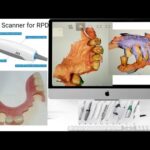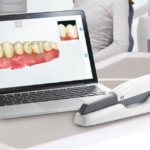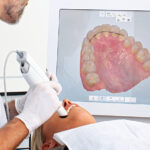Advanced Treatment Options
Intra Oral Scanner
An intraoral scanner (IOS) is a dental device used by dentists and orthodontists to capture highly detailed three-dimensional images of a patient’s teeth, gums, and oral structures. It is a modern alternative to traditional dental impressions, where patients had to bite into a tray filled with dental impression material to create moulds of their teeth.
The intraoral scanner consists of a handheld wand or camera-like device that uses optical technology, such as lasers or structured light, to scan the patient’s oral cavity. As the wand is moved around the mouth, it captures numerous images, which are then processed in real-time to create a complete digital 3D model of the patient’s teeth and surrounding tissues.
BENEFITS OF INTRAORAL SCANNERS:
- Improved patient comfort: Intraoral scanning eliminates the need for messy impression materials, making the process more comfortable and less intimidating for patients, particularly those with sensitive gag reflexes.
- Faster and more efficient: The scanning process is quicker compared to traditional impressions, reducing chair time and allowing for more efficient treatment planning.
- Accurate and detailed images: Intraoral scanners produce high-resolution digital models, providing dentists with precise and detailed information to plan and execute treatments effectively.
- Better communication: The digital models can be easily shared with patients and other dental specialists, fostering better communication and collaboration in complex treatment cases.
- Digital records and storage: The scanned data can be securely stored in a patient’s electronic health record, simplifying record-keeping and facilitating easier access to information when needed.
Intraoral scanners are commonly used in various dental applications, including restorative dentistry (crowns, bridges, and veneers), orthodontics (Invisalign and other clear aligner treatments), and implant dentistry (planning and placement of dental implants).



